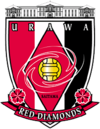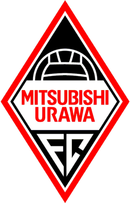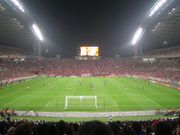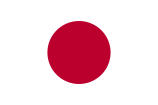Urawa Red Diamonds
 |
|||
| Full name | Urawa Red Diamonds | ||
|---|---|---|---|
| Nickname(s) | Reds (レッズ Rezzu) | ||
| Founded | 1950 | ||
| Ground | Urawa Komaba Stadium and Saitama Stadium 2002 (Capacity: 21,500 and 63,700) |
||
| Chairman | |||
| Manager | |||
| League | J. League Division 1 | ||
| 2009 | 6th Place | ||
|
|||

Urawa Red Diamonds (浦和レッドダイヤモンズ Urawa Reddo Daiyamonzu) are a professional football club playing in Japan's football league, J. League Division 1. One of Japan's best supported teams, the club has been able to boast the highest average crowds for ten of the J-League's seventeen season history. In 2008 the team attracted an average gate of over 47,000, which included one game at the smaller Komaba stadium, the highest in both Japan and Asia as a whole. The club moved in 2001 to the newly built Saitama Stadium, and were able to accommodate a sharp increase in crowd numbers between 2003 and 2006; a period rich in silverware. Its hometown is the city of Saitama in Saitama Prefecture.
Contents |
History
Mitsubishi Motors established a football club in 1950[1] and in 1965 it formed the Japan Soccer League along with today's Sanfrecce Hiroshima, JEF United Ichihara Chiba, Kashiwa Reysol, Cerezo Osaka and three other clubs who have since been relegated to regional leagues.
Mitsubishi first won the JSL championship in 1969, as a break in Mazda/Sanfrecce's dominance (and also with the fact that Toyo were in Bangkok, Thailand, competing in the Asian Club Cup); their runs up the first division were sporadic but steady until the 1980s when they fell into the Second Division. In 1990 they were promoted as JSL 2 champions, and thus were ready when the J-League implementation began in earnest.
Mitsubishi were the first Japanese club to complete a domestic treble, when in 1978 they won the title, the Emperor's Cup and the Japan Soccer League Cup.
The club has enjoyed mixed fortunes since the J-League advent. The club finished bottom of the league for the first two seasons of the J-League with an average crowd of under 15,000. In 1999 they suffered relegation to the second tier of Japanese football yet again. The team has since improved in form in recent years, starting with a 2003 victory in the Nabisco Cup.
In 2006 Urawa clinched their first professional league title by defeating runners-up Gamba Osaka 3–2 on December 2 before 63,000 supporters. This came after two close calls in the previous two years. In 2005, they finished 2nd, one point behind champions Gamba Osaka. In 2004, they finished 3rd in the First Stage and won the Second Stage. Having qualified for the two-match J. League Championship decider, they lost on penalty kicks to Yokohama F. Marinos.
Urawa were back to back Emperor's Cup winners in 2005 and 2006. Winning the title for the first time since establishment as a professional team, they defeated Shimizu S-Pulse 2–1 on January 1, 2006, and retained the title in 2007 with a 1–0 win over Gamba Osaka. This win also completed a league-cup double. In the 2007 tournament they were defeated at the first hurdle by J2 outfit Ehime F.C..
In 2007, despite a seemingly unassailable lead of seven points with four games remaining, Urawa picked up only two points from their final four games. This run included losing at home to Kashima Antlers; the team who would leapfrog Urawa on the final day of the season to claim their fifth J. League title. Following their capitulation in the fourth round of the Emperor's Cup to J2 outfit Ehime F.C., Urawa had to be content with their 2007 Asian Champions League title. Urawa recorded their first international title after overcoming Iranian team Sepahan F.C. 3–1 on aggregate. The victory made them the first Japanese side to win the title since the competition was reorganised from the Asian Champions Cup in 2003. In the Club World Cup of the same year, Urawa became the first AFC team to finish in third place, beating Tunisian Étoile Sportive du Sahel side on penalty kicks in the third / fourth place play off.
In 2008, Urawa attempted to win their second consecutive Asian Champions League Title and progressed to the semi finals where they were defeated by fellow Japanese and J-League rivals Gamba Osaka 3–1 on aggregate.
International affiliation
The club is also notable in that former Feyenoord midfielder Shinji Ono began his professional career playing for Urawa. Ono returned for the 2006 season for a second stint with the club. Urawa is affiliated with German club FC Bayern Munich, whose nickname is also "The Reds". [2] Karl-Heinz Rummenigge, the chairman of the FC Bayern Munich, announced that "We have been looking for clubs which have potential ability, management stability and cordial confidence. We could fulfill the desire to affiliate with this great club, Urawa Reds."[3] Some other foreign clubs, such as Club Atlético Independiente, Clube de Regatas do Flamengo, VfB Stuttgart, Manchester United F.C., Feyenoord and Hamburger SV, visited Japan and played friendly games at the Saitama Stadium.
In August 2004, Urawa appeared in a pre-season four-team friendly tournament, the Vodafone Cup, at Old Trafford, the home of Manchester United. The Japanese club, missing key players, lost their first game 5–2 against the Argentinian side Boca Juniors. The second fixture against the hosts, Manchester United, was called off due to a massive electric storm. Some 800 Urawa fans had travelled to the game and were later compensated.
Stadium

Since the establishment of J. League in 1992, the team had used tracked Urawa Komaba Stadium as its home stadium. Due to the increasing popularity of the matches, Saitama City, owner of the stadium, expanded the seat capacity some times. The team used Ōmiya Park Soccer Stadium until the works were complete. In spite of the poor performance of the team, the stadium was filled with faithful supporters, drew an average audience of twenty thousand people.
In October 2001, Saitama Prefecture built new soccer-specific Saitama Stadium in Saitama city. This stadium was used as a venue for the 2002 FIFA World Cup. After the World Cup the club has gradually increased holding its home games in Saitama Stadium and in 2003 the stadium was formally designated as the home stadium. In 2008, only two games were held at Komaba Stadium.
Facilities
Urawa Reds has used Ohara City Field for its training. In addition to this facility, the club opened the Redsland in 2005, which have three grass fields, one artificial turf field, one baseball field, futsal fields and tennis courts.[4] The Redsland is opened to the public and club members can use the facilities at relatively cheap fees.
Rivalries
Urawa Red Diamonds has a local derby with Omiya Ardija, from Omiya-ku, Saitama city. The derby first took place in the JSL Second Division in the 1989–90 season, and it wouldn't take place until the 2000 season when Urawa was relegated to the second tier again. In 2003 the formerly separate Omiya and Urawa cities merged to become Saitama city, and since 2005 the derby became a top flight fixture after Omiya was promoted.
During the JSL years and into the 1990s, Urawa's main top flight rivals were JEF United Ichihara Chiba and Kashiwa Reysol, both now based in Chiba Prefecture. Because of their former parent companies' headquarters being all based in Marunouchi, Tokyo, the three clubs were known as 丸の内御三家 Marunouchi Gosanke ("Marunouchi Big Three") and fixtures between them were known as Marunouchi derbies, although the term is falling out of use as they are now based in different prefectures and rarely play home games in Tokyo stadiums.
Rivals further afield include Kashima Antlers, F.C. Tokyo, Yokohama Marinos, Kawasaki Frontale, and, even farther away, Gamba Osaka. Old JSL championship rivalries with Sanfrecce Hiroshima, Cerezo Osaka and Shonan Bellmare have ebbed down as those clubs had nadirs in the second tier.
Women's and Amateur Teams
The club also has women's and amateur teams.
- Women's: Urawa Red Diamonds[5] – Ladies in L. League Division 1
- Amateur: Urawa Red Diamonds – Amateur in Saitama Prefecture League Div. 1
Record as J. League member
| Season | Div. | Tms. | Pos. | Attendance/G | J. League Cup | Emperor's Cup | Asia | |
|---|---|---|---|---|---|---|---|---|
| 1992 | - | - | - | - | Group Stage | Semi-final | - | - |
| 1993 | J1 | 10 | 10 | 11,459 | Group Stage | 2nd Round | - | - |
| 1994 | J1 | 12 | 12 | 18,475 | Quarter-final | 3rd Round | - | - |
| 1995 | J1 | 14 | 4 | 19,560 | - | Quarter-final | - | - |
| 1996 | J1 | 16 | 6 | 24,329 | Group Stage | Semi-final | - | - |
| 1997 | J1 | 17 | 10 | 20,504 | Quarter-final | 4th Round | - | - |
| 1998 | J1 | 18 | 6 | 22,706 | Group Stage | Quarter-final | - | - |
| 1999 | J1 | 16 | 15 | 21,206 | Quarter-final | 4h Round | - | - |
| 2000 | J2 | 11 | 2 | 16,923 | 1st Round | 4h Round | - | - |
| 2001 | J1 | 16 | 10 | 26,720 | Quarter-final | Semi-final | - | - |
| 2002 | J1 | 16 | 11 | 26,296 | Final | 3rd Round | - | - |
| 2003 | J1 | 16 | 6 | 28,855 | Winner | 3rd Round | - | - |
| 2004 | J1 | 16 | 2 | 36,660 | Final | Semi-final | - | - |
| 2005 | J1 | 18 | 2 | 39,357 | Semi-final | Winner | - | - |
| 2006 | J1 | 18 | 1 | 45,573 | Quarter-final | Winner | - | - |
| 2007 | J1 | 18 | 2 | 46,667 | Quarter-final | 4th Round | CL | Winner |
| 2008 | J1 | 18 | 7 | 47,609 | Group Stage | 5th Round | CL | Semi-final |
| 2009 | J1 | 18 | 6 | 44,210 | Quarter-final | 2nd Round | - | - |
- Key
- Tms. = Number of teams
- Pos. = Position in league
- Attendance/G = Average league attendance
Honors
Domestic Competitions
Mitsubishi (Amateur era)
- Japan Soccer League Division 1
- Champions: (4) 1969, 1973, 1978, 1982
- Japan Soccer League Division 2
- Champions: (1) 1989/90
- Emperor's Cup
- Winners: (4) 1971, 1973, 1978, 1980
- JSL Cup
- Winners: (2) 1978, 1981
- Super Cup
- Winners: (3) 1979, 1980, 1983
Urawa Red Diamonds (Professional era)
- J. League Division 1
- Champions: (1) 2006
- Runners-up: (3) 2004, 2005, 2007
- J. League Division 2
- Runners-up: (1) 2000
- Emperor's Cup
- Winners: (2) 2005, 2006
- J. League Cup
- Winners: (1) 2003
- Runners-up: (2) 2002, 2004
- Super Cup
- Winners: (1) 2006
- Runners-up: (1) 2007
Continental
- AFC Champions League
- Winners: (1) 2007
International
- FIFA Club World Cup
- Third Place: (1) 2007
Individual Awards
See Individual Award Winners (Urawa Red Diamonds)
Players
Current Squad
As of July 17, 2010 Note: Flags indicate national team as has been defined under FIFA eligibility rules. Players may hold more than one non-FIFA nationality.
|
|
Out on loan
Note: Flags indicate national team as has been defined under FIFA eligibility rules. Players may hold more than one non-FIFA nationality.
|
World Cup players
 Masayuki Okano
Masayuki Okano Shinji Ono
Shinji Ono Željko Petrović
Željko Petrović
 Shinji Ono
Shinji Ono Alessandro Santos
Alessandro Santos Keisuke Tsuboi
Keisuke Tsuboi Naohiro Takahara
Naohiro Takahara
 Yuki Abe
Yuki Abe
International Players
|
|
|
|
|
Managers
| Manager | Nat. | Tenure |
|---|---|---|
| Takaji Mori | 1993 | |
| Kenzo Yokoyama | 1994 | |
| Holger Osieck | 1995-96 | |
| Horst Köppel | 1997 | |
| Hiromi Hara | 1998-99 | |
| Aad de Mos | 1999 | |
| Yasushi Yoshida | 1999 | |
| Kazuo Saito | 2000 | |
| Kenzo Yokoyama | 2000 | |
| Tita | 2001 | |
| Pita | 2001 | |
| Hans Ooft | 2002-03 | |
| Guido Buchwald | 2004-06 | |
| Holger Osieck | 2007-08 | |
| Gert Engels | 2008 | |
| Volker Finke | 2009- |
League history
Excepting two seasons in which they were in the second tier, Mitsubishi/Urawa has always competed in the top flight, thereby being the second club in terms of top flight seasons total after JEF United Ichihara Chiba.
- Mitsubishi (Amateur era)
- Division 1 (JSL and JSL Div.1) : 1965-66, 1988-89
- Division 2 (JSL Div.2) : 1989-90
- Division 1 (JSL Div.1) : 1990-91, 1991-92
- Urawa Red Diamonds (Professional era)
- Division 1 (J. League) : 1993-99
- Division 2 (J. League Div.2) : 2000
- Division 1 (J. League Div.1) : 2001-
- Top Scorer: Masahiro Fukuda with 152 goals
References
- ↑ 浦和レッズ年表, Urawa Red Diamonds
- ↑ partner Urawa seal domestic double, FC Bayern
- ↑ 06.01.18 FCバイエルン・ミュンヘン(ドイツ)とのパートナーシップ締結について, Urawa Red Diamonds
- ↑ レッズランド | 浦和レッズ, Urawa Red Diamonds
- ↑ URAWA REDS LADIES, Urawa Red Diamonds
External links
- (English) Urawa Red Diamonds Official Site
- (Japanese) Urawa Red Diamonds Official Site
- (Japanese) Urawa Red Diamonds Supporters Media Site (unofficial)
| Awards and achievements | ||
|---|---|---|
| Preceded by Japan national baseball team |
Japan Professional Sports Grand Prize Winner 2007 |
Succeeded by Ryo Ishikawa |
| Sporting positions | ||
| Preceded by Jeonbuk Hyundai Motors |
Champions of Asia 2007 |
Succeeded by Gamba Osaka |
|
|||||||||||
|
||||||||||||||||||||||||||||||||||||||||||||||||||||||
|
|||||||||||||||||||||||||||||||||||||||||||||||||||||||||||||||||||||||||||||||||||||||||||||||||||||||
|
||||||||